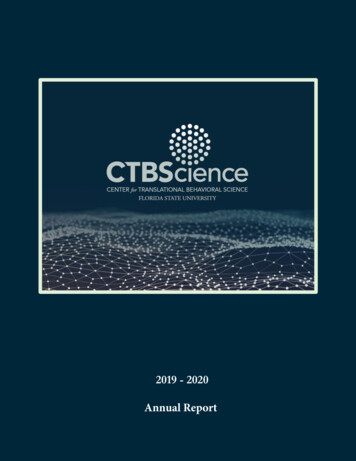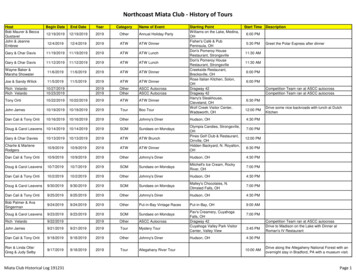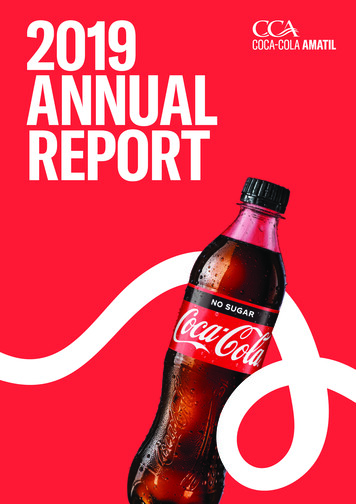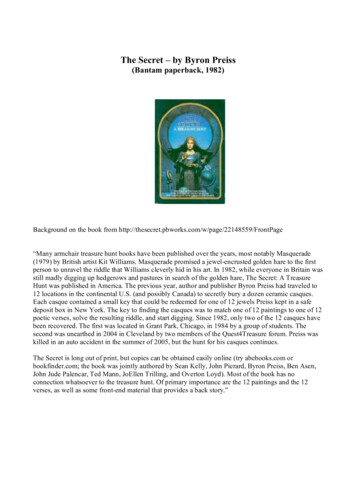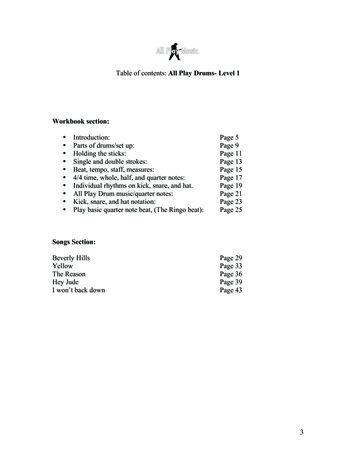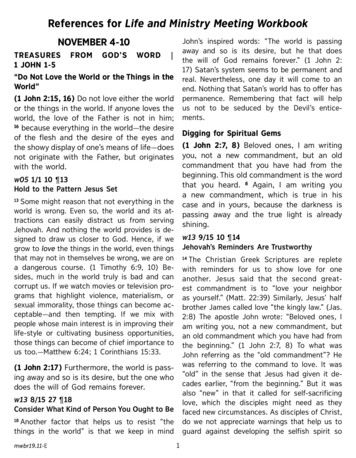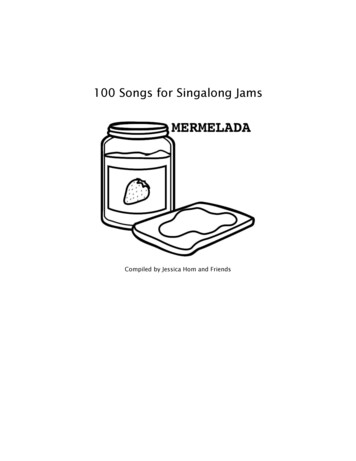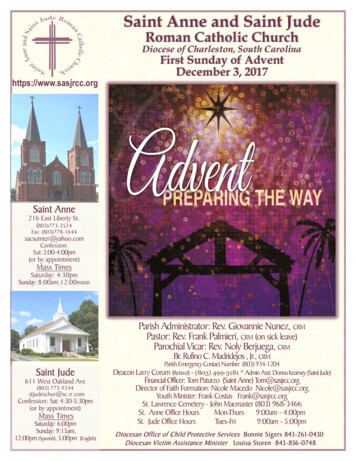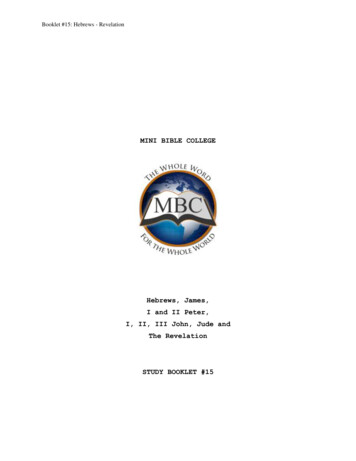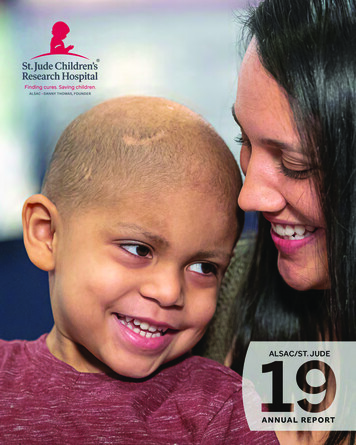
Transcription
VictoriaArt plays a bigrole in thepatientexperienceArt therapy is often used toreduce stress or anxiety,explore complex feelings,manage side effects andimprove quality of lifefor patients. Patient art isalso used by ALSAC, thefundraising and awarenessorganization for St. Jude, toraise awareness and support.Scan the QR code with your smartphone camera or go toexperience.stjude.org to download the St. Jude Experience app.Select the St. Jude Patient ARt experience, hold your phone upwith the art in view and watch it come to life.
ALSAC/ST. JUDE2019ANNUAL REPORTCONTENTS10 All For OneThe family that survivestogether, thrives together.For this mom and her babies,St. Jude means memories,love and life.20A NewCure04 Global Alliance06 New and Notable16 SongbirdFor Tiara Herr, music is life. Leftlegally deaf from treatment fora rare cancerous tumor, shecontinues with her passion forsinging, performing and teaching.32This ShirtSaves Lives19 St. Jude Brand23 Research Highlights26 One Big FamilyThey met and bonded throughtreatment at St. Jude. When theylost their kids to cancer, these twofamilies comforted and upliftedeach other, and continue today.44ParentLetter34 Legacy and Leadership42 FinancialsSt. Jude Children’s Research Hospital is leading the way the world understands, treats and defeats childhood cancer and other lifethreatening diseases. As a cutting-edge research institution, world-class children’s hospital and America’s largest healthcare charity,we are dedicated to one goal: Finding cures. Saving children. Even in these challenging times, there is still St. Jude — thanks to you. You can help ensure familiesnever receive a bill from St. Jude for treatment, travel, housing or food. Visit stjude.org/donate
It is estimated that there are more than 400,000 new cases ofchildhood cancer around the world annually. More than 90 percentof those cases are located in low- to middle-income countrieswithout adequate resources for diagnosis or treatment. In an effortto improve outcomes, St. Jude Global was launched to reducedisparities and improve access to, and quality of, care for childrenwith cancer worldwide. In December 2018, St. Jude Children’sResearch Hospital welcomed more than 160 representatives from52 countries to Memphis, Tennessee, to launch the St. Jude GlobalAlliance, which forms a structure to provide advanced care acrossseven regions of the world. By drawing on a half-century’s worth ofmedical advances and expertise in care, St. Jude can turn the tide onchildhood cancer and ensure where a child lives no longer dictatesthat child’s health care outcome.By sharing our knowledge freely and exchanging ideas openly,we’re inspiring more collaboration between doctors andresearchers worldwide, and, as a result, providing more lifesavingtreatments for children everywhere.With our global partners, bringing quality care and cures to childrenwith cancer everywhere in the world is now possible. We realize thiswon’t happen overnight; it’s a long process that will require the bestof us, but we embark on this challenge with this promise to all thechildren in the world with cancer: We have heard your call, we arehere, and we are ready. We will not fail you.— Dr. Carlos Rodriguez-Galindo, Director, St. Jude GlobalU.S. News & World Report, 20194ALSAC/St. Jude Children’s Research Hospital
St. Jude patient Jesse, brain cancer5
new & notableSt. Jude continues to push the limits of what a premier pediatric research hospital looks like. These effortswill continue until no child dies in the dawn of life. Scan the QR codes to view more of each story.St. Jude Cloud Accelerates Scientific DiscoveriesSt. Jude Cloud, a partnership with DNAnexusand Microsoft, launched in 2018 as an onlinedata-sharing and collaboration platformproviding researchers around the globe accessto the world’s largest repository of pediatricgenomics data. Since then, more than 14,5006ALSAC/St. Jude Children’s Research Hospitalgenomes of pediatric patients and survivors havebeen released through St. Jude Cloud, and morethan 90,000 worldwide users have accessed theinformation. With such sharing and collaboration,the fight against childhood cancer and otherlife-threatening diseases is truly a global effort.
National CancerInstitute BestowsHighest Ratingon St. JudeFor the second time in a row, the NationalCancer Institute awarded St. Jude Children’sResearch Hospital the highest possible rankof “exceptional” and the best numerical scorein the hospital’s history during renewal of thehospital’s 30 million Comprehensive CancerCenter grant.St. Jude is the first and only NCI-designatedComprehensive Cancer Center that isdevoted solely to children. The designationand accompanying grant funds must berenewed every five years; St. Jude firstearned an “exceptional” score in 2013.St. Jude has had the designation as anNCI Cancer Center since 1977, and firstachieved comprehensive cancercenter status in 2008.Artwork by St. Jude patient JadenMartine Roussel, Ph.D., of St. Jude Electedto the National Academy of SciencesMartine Roussel, Ph.D., a memberof the Department of Tumor CellBiology and co-leader of the CancerBiology Program at St. Jude, waselected to the National Academyof Sciences. Roussel was one of100 new members and 25 foreignassociates recognized by therenowned society of scholars fortheir distinguished and continuingachievements in original research.Roussel joined St. Jude in 1983as a research associate in theDepartment of Tumor CellBiology. She is a full memberand holds the Endowed Chairin Molecular Oncogenesis.Her appointment marksa historic moment for theNational Academy of Scienceswith a record number of womenelected to the academy.7
8ALSAC/St. Jude Children’s Research Hospital
— Aubrey’s mom, MelindaAubrey was diagnosed with medulloblastoma, a brain tumor, at 9 years old. At St. Judeshe underwent surgery, chemotherapy and radiation therapy. Today, Aubrey is cancerfree and regularly visits St. Jude for checkups while once again enjoying the thing sheloves most in the world — dancing. To read more about Aubrey’s story, scan the codeor visit: stjude.org/aubreyFinding cures. Saving children. 9
10ALSAC/St. Jude Children’s Research Hospital
Mom, son and daughter each weretreated for acute lymphoblasticleukemia (ALL) at St. Jude. Butthe tie that really binds them isa sense of family that never quit.ALLFORONEFinding cures. Saving children. 11
Javon can tell you about his yearsand years of treatment for acutelymphoblastic leukemia (ALL). Hecan tell you about his two relapses —including one that was discovered on the veryday he was scheduled to finish chemotherapy.He can tell you about his bone marrow transplant,after which he slept for days, then woke uptemporarily without his memory — asking hismom, as she hugged him, “Who are you?”He can tell you about friends made and friends lostamong his fellow patients, and the time he startedhiding his medicine because he was “sad anddepressed,” but also because “those were somebig, ol’ pills.”But perhaps the most telling moment of this18-year-old college freshman and St. Jude cancersurvivor’s tale comes when he says, “Two years ago,I literally learned how to ride a bike.”People laugh when he tells them. They naturallywonder: How are you a teenager and just learnedhow to ride a bike? That’s when he tells themabout his childhood, the one he really didn’t have.The one cancer stole. That’s when he tells themabout his family, a source of love, strength andhope that carried him through — that carriedthem all through.LITTLE SISTERJakayla, 13, can relate. She was a familiar sight in thehalls of St. Jude as a patient sibling — Javon’s littlesister — before she, too, was diagnosed with ALL.She can also tell you what it’s like to relapse.She can tell you about her own bone marrowtransplant. And she, like Javon, can tell youabout the difficulty she had relating to schoolmates and others whose childhoods weren’tmarred by a catastrophic disease.“I couldn’t really tell people how I feel about havingcancer,” she says. “It’s hard for people.”This is a girl, after all, who attended her St. Judekindergarten graduation via Skype from thebone marrow transplant floor. It helps, then, tohave somebody close who really understands.Somebody who’s been there, like a big brother.Or a mother. Yes — her, too.MOM AND HER BABIESSome 25 years before Lisa was a mom with twochildren simultaneously undergoing chemotherapyfor ALL, she was a St. Jude patient with the samedisease. She relapsed, too. She made dear friendsonly to lose them. She remembers seeing otherpatients who had lost limbs and asking her ownmom, “Am I going to get my leg cut off, or my arm?”She can tell you all that, and also how she copedpost-cancer:“I just put it in the closet and never thoughtabout it.”This strategy worked until it didn’t. Until, she says,“my baby” was diagnosed. That was Javon, in2003, at age 2. Five years later, 2-year-old Jakaylawas diagnosed.12ALSAC/St. Jude Children’s Research Hospital
Imagine if nearly all of yourchildhood memories tookplace in a hospital.Mother. Son. Daughter. In fact, the family’sconnection with ALL — and with St. Jude —is deeper still. Lisa had a relative who wassuccessfully treated at St. Jude for ALL in thelate 1990s, and another relative who was an ALLpatient in the early 1960s who did not survive.The family’s history spans nearly the hospital’shistory, from those early days when the survivalrate for ALL was 4 percent. Today, it’s 94 percent.But the connection between the familial cases— if there’s a connection — isn’t yet known, thefamily says. “We’ve been doing genetic testingand everything,” Lisa says. “It’s a link in theresomewhere.” Javon calls it “the biggest puzzle.”THE DAY MICHELLE OBAMA VISITED ST. JUDEWhat are your most vivid childhood memories?Ballgames and dance recitals? School days andbeach vacations? Secrets shared with best friends?Imagine if your best friendsall had cancer.Imagine if nearly all of your childhood memoriestook place in a hospital. Imagine if your best friendsall had cancer.That’s the case for Javon, whose treatment was thelongest and most fraught of the family. He didn’tattend a traditional school until sixth grade. Beforethat, he was educated at St. Jude, which has a K-12school program.“I made so many friends I lost count,” Javon saysof his St. Jude childhood. “We’d pretty much talkabout everything” — from their low ANCs (absoluteneutrophil count, a reflection of the body’s abilityto fight infections) to their next chemo treatmentsto why they had to wear masks. “We’d pretty muchtalk about medical stuff at a very young age. But,Finding cures. Saving children. 13
At one point, hestops himself,Wow Nowthat I thinkabout it, I’vebeen througha lot as a child.at the same time, we were goofing around. Haveyou seen Power Rangers? We had a lot of fun.”“My favorite, hands down,” Javon says. “She was sowelcoming and nice. Oh, she was the best.”Javon smiles — an unmistakable after-effect of allhis years at St. Jude. It’s the same for the rest ofthe family. “We’ll laugh about it,” Lisa says. “We’llbasically talk about the good times we had.”For mom, a celebrity meeting almost made up forher greatest missed opportunity. She slept througha visit by St. Jude founder Danny Thomas duringher own patient days in the mid-1980s.That’s by design at a hospital where treatmentallows kids to be kids, where laughter is medicine,too. St. Jude is doctors, nurses and therapists,but some of them play guitar and sing. St. Judeis transplants, proton therapy and clinical trials,but also school, new friends and hanging outwith celebrities.“The Benadryl had knocked me out,” she says. “Mymom even said he stood over me. And I’m like,‘Wow. And why didn’t you wake me up?’”“Oh, celebrities,” Lisa says — and there’s that familysmile again. The best was when First Lady MichelleObama visited St. Jude in 2014. “She gave me somecandy and cookies,” says Jakayla.14ALSAC/St. Jude Children’s Research HospitalThey have the other kind of stories, too, of course.A happy hospital is still a hospital. And, when askedif he ever worried he might not survive, Javon tellsthis story:“That moment was when I had my transplant. Itwas like a horror story, slash, a good story. I’ll neverforget this night. It was storming so bad that the
lights went out. Then all the transplant patients likeme were moved to the hallway. They had to almostpostpone my transplant, because the lights wentout so bad.”“After the lights came back on, I had to go tomy transplant. They had to put the cells into myHickman line. The lights almost went right backoff. I was panicking. My heart rate was going high.Everybody thought I was going into shock, and Iwas panicking so bad.”After the transplant, Javon says, he blacked out. Inhis admittedly exaggerated version of events, hewas asleep for probably two weeks. “Completelynormal sleep,” he says, “For two weeks.”When he awoke, he didn’t recognize his mom,didn’t know where he was, and seemed to haveforgotten he had cancer. He began to unhookand unscrew everything connected to him.“I almost yanked on my Hickman line — almost,”he says of the tube through which patients receivechemotherapy and other drugs.Javon says it was another week before “I caughtup with my memory.”There’s amazement in his voice as he speaks. Heseems to marvel at his own stories, as if they musthave happened to someone else entirely, or maybeto a character in a movie. At one point, he stopshimself. “Wow. I’ve been through hell and back.Now that I think about it, I’ve been through a lotas a child.”SURVIVING TOGETHER, THRIVING TOGETHERJavon now is a college freshman. He playstrombone in the marching band. Life is “awesome.”Jakayla is an eighth-grader. She’s soft-spoken, butmaybe she’d just rather sing than talk. “I’m in theschool choir,” she says.Lisa is a proud mom, though she makes no claim onthe music her kids are putting out into the world. “Idon’t know where they get it from,” she says. “Theydidn’t get it from me.”Javon, 11 years old and Jakayla, 6 years old in 2012They did get her strength and perseverance, itseems, and a sense of family that does not quit.They’re tight. You can tell by the way they interact,and the way they talk about each other. Javon saysJakayla is “a fun spirit, and she’s like a little diva.”Lisa says of her daughter: “She’s more open nowthan she was. She’s more energetic now. The choirthing, I never thought she’d be doing. She’s been incompetition. We went to Florida, she sang in frontof all those people. I never thought she would havedone that. She’s started coming out more. She wasvery shy.”Then there’s Javon’s bond with his mom. He callsher every day, though campus is just 20 miles fromhome. And so many of his stories involve her, likethe one about relapsing just as chemotherapywas ending:“Younger me thought I was going to go back tobeing a normal little boy,” Javon says. “I noticedmy mom was crying, but I thought she was cryingfor joy. But she was trying to explain to me that Ihad relapsed.“Younger me was like, ‘I don’t care, Mama, I’m herewith you.’ That’s what I remember saying — ‘I don’tcare, Mama, I’m here with you.’”They’re still here, all of them. Lisa. Javon. Jakayla.Mother. Son. Daughter. A St. Jude success story,times three.Finding cures. Saving children. 15
For Tiara Herr,legally deaf fromtreatment forneuroblastoma,music is a ‘fullbody experience.’This St. Judesurvivor sings,plays piano,performs inmusical theaterand teachesvoice lessons.She sits at the piano and strikes a key with herright hand. A note resounds through the room.“This high F up here?” says Tiara Herr, legallydeaf since childhood, an effect of heryears-long treatment for neuroblastoma.“That’s where I stop being able to hear. I justhear clacking.“So when I listen to music, and there’s all thishigh stuff, I don’t experience that. But what Ican experience is really cool. I’ll be playing, andI can lay my head on the piano and I can feelthe vibrations coming through my bones.”Now 27 years old, Tiara can’t hear high notes,fire alarms, phones ringing or birds singing, yet16ALSAC/St.ALSAC/St. Jude Children’s Research Hospitalshe plays piano, writes and sings original songs.She performs in musical theater, most recentlya revival of “South Pacific.” She even gives voicelessons. Drawing on a love of science sparked bySt. Jude Children’s Research Hospital, she nowteaches singing as a “full-body experience.”‘Lost in music’The little girl in the frilly dress would runthrough the hospital hallways, singing atthe top of her lungs.“I would sing in every part of the hospital,”Tiara says, now sitting at the piano in herrustic Oregon home, some 20 years and2,000 miles removed from St. Jude inMemphis. “They probably knew I was coming
Finding cures. Saving children. 17
because they could hear this little kid singingthese cute songs.”Nothing could silence her. Not the tumors,which would eventually grow to be forty. Notthe treatment, which included dozens ofsurgeries, chemotherapy, radiation therapyand a bone marrow transplant.“I try to remember the little girl running throughthe hallways,” she says. “She didn’t seem like shehad a care in the world, but in reality she wasfighting for her life every second of every day.“I need to do a lot of reflection to rememberthat that girl is still in me.”Oh, she’s still there.She’s at the piano now, not just playing butexpressing. Not just hearing but experiencing.She’s talking about the science of her art, andhow feeling the notes she plays “really tells mewhether that music is going to be effective atconveying what I’m feeling in that moment.”Her playing, like her singing, has power andforce. She favors dissonant chords, which shejokes are “awesome and angsty.” It’s an aptsoundtrack for someone who defied deathmore than once as a child, and who copes as anadult with chronic pain, anxiety and depression.Music helps. It always has. Music is relief andrelease. Music is salve and salvation.“Music is so expressive,” says Tiara. “By singing,I’m showing everybody that my deafnessdoesn’t hold me back. That all this trauma thatI have from being a childhood cancer survivordoesn’t hold me back. Because I can get lost inmusic and forget that ever happened to me.”“I try to play or sing as much music as Ican, because that is the one thing thatis guaranteed to lift me up.”Because what the little girl knew in her heart,the woman feels in her bones: When you can’thear a bird’s song, be your own songbird.18ALSAC/St. Jude Children’s Research Hospital
1234567Health NonprofitBrand of the Year7 YEARS IN A ROW(HARRIS POLL EQUITREND STUDY)St. Jude has the HighestFavorability of All MajorNonprofitsCLEARVANTAGE BRAND HEALTH STUDYST. JUDEBRAND ATA GLANCEAs of June 2019St. Jude has been namedone of The Top 4 Places toWork by Millennials andGen Z for 8 years in a rowNATIONAL SOCIETY OF HIGH SCHOOL SCHOLARSMost InspirationalBrandWORLD VALUE INDEXNearly 9 out of 10Americans recognizethe St. Jude BrandCLEARVANTAGE BRAND HEALTH STUDYMost Loved Brand7 YEARS IN A ROWHARRIS POLL EQUITREND STUDYArtwork by St. Jude patient Kiera19
Omarion, born with a rare genetic disorder called X-linked Severe Combined Immunodeficiency, or bubble boy disease,explores playground equipment after his immune system was reconstituted through gene therapy developed at St. Jude.20ALSAC/St.ALSAC/St. Jude Children’s Research Hospital
The announcement in April 2018 that gene therapy developed at St. Jude Children’s ResearchHospital cured infants born with so-called “bubble boy” disease generated coverage from the likesof The Washington Post and ABC News, not to mention international media outlets. At the sametime, the news proved especially gratifying for longtime St. Jude supporters who, year after year,underwrite studies that rarely garner headlines.“We’re delighted,” said Jan Young, executive director of The Assisi Foundation of Memphis. “We
also used by ALSAC, the fundraising and awareness organization for St. Jude, to raise awareness and support. Scan the QR code with your smartphone camera or go to experience.stjude.org to download the St. Jude Experience app. Select the St. Jude Patient ARt experience, hold your
